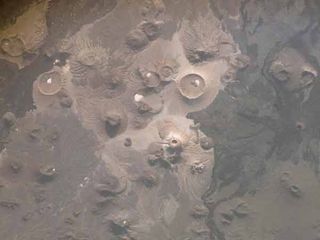
Harrart Khaybar: One of Saudi Arabia's Largest Volcanic Fields

This image, taken by a crew aboard the International Space Station in March 2008 and released by NASA last week, shows Harrat Khaybar, one of the largest volcanic fields in Saudi Arabia.
Harrat Khaybar lies in the western half of the Arabian Peninsula and contains large expanses of sand and gravel, as well as the extensive lava fields known as haraat (harrat for a named field).
Harrat Khaybar covers an area of more than 5,400 square miles (14,000 square kilometers) north of Medina, Islam's second holiest city, in the west of Saudi Arabia.
According to scientists, the volcanic field was formed by eruptions along a long, north-south linear vent system over the past 5 million years; the most recent recorded eruption took place between 600 and 700 A.D.
Harrat Khaybar contains a wide range of volcanic rock types and spectacular landforms, several of which are represented in this image. Jabal ("mountain" in Arabic) al Qidr is built from several generations of dark, fluid basalt lava flows and can be seen as a dark patch to the far right of the image.
The presence of tuff cones formed by eruption of lava in the presence of water together with other volcanic features indicative of water in the Harrat Khaybar suggest that the local climate was much wetter during some periods of volcanic activity . Today, however, the regional climate is hyperarid meaning there is little to no yearly precipitation leading to an almost total lack of vegetation in the area.
- The World's Five Most Active Volcanoes
- Image Gallery: Volcanoes From Space
- The Harshest Environments on Earth
Sign up for the Live Science daily newsletter now
Get the world’s most fascinating discoveries delivered straight to your inbox.

